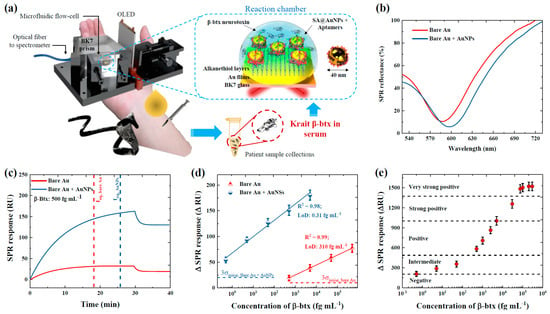Abstract
This study introduces a portable gold-nanoparticle-enhanced surface plasmon resonance (SPR) biosensor for the swift and highly sensitive detection of β-bungarotoxin in krait venom. Demonstrating a 103-fold increase in sensitivity over traditional SPR sensors, this compact tool underscores the potential of portable SPR biosensors for efficient point-of-care venom diagnostics.
1. Introduction
There is a significant drive to establish a portable, swift, and highly sensitive method for the quantification of β-bungarotoxin (β-btx), an essential biomarker from krait venom, to replace the lateral flow quantification method, which has shown inadequate accuracy and limited capacity in providing immediate results for snake poisoning diagnoses [,]. Complementary methodologies, such as immunoassay techniques, have been introduced alongside conventional immunoassays, addressing the demand for high-sensitivity and quantitative approaches. However, these methodologies still grapple with limitations regarding portability and speed [], thus accentuating the necessity for continued advancements in krait venom detection tools. Concurrently, surface plasmon resonance (SPR) biosensors are emerging as a promising technology for the real-time, rapid, and label-free detection of various biomarkers. The portability of SPR instrumentation, characterized by its lightweight and compact design, offers a distinct advantage [,]. As such, the diagnosis of krait poisoning could be feasibly conducted at low-cost clinics, point-of-care facilities in remote areas, in the field, or within emergency vehicles. However, quantification of β-btx via SPR biosensors has been sparsely reported in the literature [,].
In this study, we present, for the first time, a real-time, highly sensitive approach for quantifying β-btx using a label-free gold nanoparticle (AuNP)-enhanced SPR sensor chip. Incorporating AuNPs enhances the SPR curve due to an intensified localized electric field near the nanoparticle surfaces, significantly boosting sensor sensitivity. Remarkably, the detection threshold of the AuNP-enhanced SPR sensor exceeds that of traditional sensors by a factor of 103-fold. Additionally, we used serum samples to evaluate our enhanced assay’s performance and establish a qualitative–quantitative correlation, offering a practical reference for gauging the severity of krait envenomation.
2. Results and Discussion
Figure 1a presents our portable SPR instrument, which utilizes an OLED light source and a sensor chip designed for β-btx quantification. This sensor chip features 40 nm diameter AuNPs coated with streptavidin and aptamers. We analyzed β-btx concentrations from 500 fg mL−1 to 1 ng mL−1 in PBS and diluted serum. Figure 1b showcases the enhanced SPR sensitivity achieved through AuNP immobilization on gold films, leading to a deeper reflection spectrum. This enhancement is evident in Figure 1c, demonstrating a significant red shift in the SPR resonance wavelength when AuNP-modified films were used for β-btx detection. Figure 1d depicts the calibration curve of SPR response against β-btx concentration, showing higher signals for AuNP-modified films and a 99% correlation between SPR response trends. Notably, the LOD decreased from 310 fg mL−1 to 0.31 fg mL−1 with AuNPs, a 103-fold improvement. Additionally, we perform a semi-quantitative analysis and categorize the SPR signal into five grades, each corresponding to a distinct toxin level in diluted serum samples, as depicted in Figure 1e. This categorization provides a valuable guide for assessing the severity of krait bites in patients.

Figure 1.
(a) Schematic illustration of the operation procedure of the handheld SPR sensor for directly detecting β-btx in serum samples. (b) Comparison of different SPR reflection spectra either with or without AuNPs. (c) A comparison of two different SPR responses either with or without AuNPs at a fixed β-btx concentration of 500 fg mL−1. (d) SPR response as a function of β-btx concentration either with or without AuNPs. (e) SPR responses for reading and scoring the krait bite severity level.
Therefore, the highly sensitive performance and semi-quantitative mapping of our handheld SPR sensor presents it as an efficacious compact diagnostic solution for krait poisoning cases.
Author Contributions
Conceptualization, S.H.S.M., and M.J.; methodology, S.H.S.M., M.J., and C.-C.L.; software, S.H.S.M.; validation, S.H.S.M., C.-C.L., and M.J.; formal analysis, S.H.S.M., and M.J.; investigation, S.H.S.M.; resources, C.-C.L., and J.-S.Y.; data curation, S.H.S.M.; writing—original draft preparation, S.H.S.M., and M.J.; writing—review and editing, S.H.S.M., M.J., and K.-C.L.; visualization, S.H.S.M.; supervision, K.-C.L.; project administration, S.H.S.M.; funding acquisition, K.-C.L., and C.-C.L. All authors have read and agreed to the published version of the manuscript.
Funding
This work was supported and funded by the National Science and Technology Council Taiwan Project (112-2221-E-182-045, and 113-2221-E-182-002) and the Chang Gung Memorial Hospital Research Project (CMRPD2M0031).
Institutional Review Board Statement
Not applicable.
Informed Consent Statement
Not applicable.
Data Availability Statement
Data are contained within the article.
Conflicts of Interest
The authors declare no conflicts of interest.
References
- Gutiérrez, J.M.; Calvete, J.J.; Habib, A.G.; Harrison, R.A.; Williams, D.J.; Warrell, D.A. Snakebite envenoming. Nat. Rev. Dis. Primers 2017, 3, 17063. [Google Scholar] [CrossRef] [PubMed]
- Puzari, U.; Mukherjee, A.K. Recent developments in diagnostic tools and bioanalytical methods for analysis of snake venom: A critical review. Anal. Chim. Acta 2020, 1137, 208–224. [Google Scholar] [CrossRef] [PubMed]
- Masson, J.F. Surface Plasmon Resonance Clinical Biosensors for Medical Diagnostics. ACS Sens. 2017, 2, 16–30. [Google Scholar] [CrossRef] [PubMed]
- Mandala, S.H.S.; Liu, T.-J.; Chen, C.-M.; Liu, K.-K.; Januar, M.; Chang, Y.-F.; Lai, C.-S.; Chang, K.-H.; Liu, K.-C. Enhanced Plasmonic Biosensor Utilizing Paired Antibody and Label-Free Fe3O4 Nanoparticles for Highly Sensitive and Selective Detection of Parkinson’s α-Synuclein in Serum. Biosensors 2021, 11, 402. [Google Scholar] [CrossRef] [PubMed]
- Lin, Y.L.; Wu, P.F.; Wu, T.T.; Chang, L.S. KChIP3: A binding protein for Taiwan banded krait β-bungarotoxin. Toxicon 2006, 47, 265–270. [Google Scholar] [CrossRef] [PubMed]
Disclaimer/Publisher’s Note: The statements, opinions and data contained in all publications are solely those of the individual author(s) and contributor(s) and not of MDPI and/or the editor(s). MDPI and/or the editor(s) disclaim responsibility for any injury to people or property resulting from any ideas, methods, instructions or products referred to in the content. |
© 2024 by the authors. Licensee MDPI, Basel, Switzerland. This article is an open access article distributed under the terms and conditions of the Creative Commons Attribution (CC BY) license (https://creativecommons.org/licenses/by/4.0/).